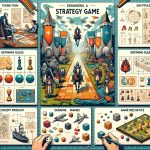Strategy board games have always been a popular form of entertainment that requires tactical thinking, strategic planning, and a touch of luck. In this article, we will explore the process of designing your very own strategy board game from start to finish. From understanding the basics of what makes a good strategy board game to brainstorming unique concepts and designing game mechanics, we will cover all aspects of the creative process.
If you’ve ever wondered how to design a strategy board game that engages players and provides a challenging yet enjoyable experience, you’ve come to the right place. With the rise of tabletop gaming in recent years, there has never been a better time to dive into the world of designing your own game that will captivate audiences and stand out in a crowded market.
Designing a strategy board game involves a combination of creativity, research, and playtesting to ensure that the final product is not only fun to play but also well-balanced and engaging. By following the steps outlined in this article, you can bring your vision to life and create a game that will entertain players for hours on end.
Whether you’re a seasoned designer looking for new inspiration or a novice just starting out, designing a strategy board game is an exciting journey that can lead to endless possibilities.
Understanding the Basics
When it comes to designing a strategy board game, understanding the basics of what makes a good game is crucial. There are key elements that contribute to the success of a strategy board game, including engaging gameplay, balanced mechanics, and strategic depth. Here are some important factors to consider when designing your own strategy board game:
- Engaging Gameplay: A good strategy board game should provide players with challenging decisions, meaningful choices, and opportunities for strategic thinking. The gameplay should be immersive and keep players coming back for more.
- Balance: Balancing the various elements of your game, such as player abilities, resources, and objectives, is essential for creating a fair playing experience. A well-balanced game allows for different strategies to succeed and keeps players engaged throughout.
- Strategic Depth: A great strategy board game offers layers of complexity that allow skilled players to explore different tactics and approaches. Strategic depth adds replay value to the game and keeps players engaged over multiple playthroughs.
In order to design a successful strategy board game, it is important to study existing games in the genre and analyze what makes them work. By examining popular strategy board games like Catan, Risk, or Ticket to Ride, you can gain valuable insights into what strategies are effective, what mechanics are engaging, and how players interact with the game. This research phase can help inspire ideas for your own unique concept and inform your design decisions moving forward.
During the brainstorming phase of designing a strategy board game, consider what sets your game apart from others in the market. Think about the theme, mechanics, player interactions, or win conditions that make your game unique. By focusing on creating a distinctive experience for players, you can differentiate your game from existing titles and attract a dedicated fanbase. Remember that innovation and creativity are key when designing a successful strategy board game that stands out in a crowded market.
Research and Inspiration
When it comes to designing a strategy board game, one of the key steps is to research and draw inspiration from existing games in the genre. By studying successful strategy board games, you can gain insights into what mechanics work well, how players interact with the game, and what elements contribute to an engaging gameplay experience.
This process of research and inspiration can help you understand the landscape of strategy board games and identify opportunities to create something unique and innovative.
Examining Game Mechanics
One important aspect of researching existing strategy board games is analyzing their game mechanics. Dive deep into how different games implement strategic decision-making, resource management, player interaction, and other key gameplay elements.
Understanding the mechanics that drive successful strategy board games will allow you to identify common patterns as well as areas where you can introduce your own twists and innovations. Consider how the mechanics contribute to the overall player experience and think about how you can design mechanics that align with your game’s theme and objectives.
Exploring Themes and Settings
In addition to studying game mechanics, exploring themes and settings in existing strategy board games can provide valuable inspiration for your own design. Consider the variety of themes used in popular strategy board games – from historical conflicts to fantasy realms to futuristic civilizations. Think about how different themes impact player engagement, immersion, and overall enjoyment of the game.
When designing your own strategy board game, choose a theme that resonates with your target audience and enhances the gameplay experience. Use existing games as a reference point for how theme and setting can be integrated seamlessly into the mechanics and components of a game.
By immersing yourself in the world of strategy board games through research and inspiration from existing titles, you can gather a wealth of knowledge that will inform your own design process. Take note of what works well in successful games, but also be open to experimentation and innovation as you brainstorm ideas for your unique strategy board game.
Drawing upon the lessons learned from studying existing games will help you create a compelling gameplay experience that captivates players and stands out in a crowded market.
Brainstorming Ideas
Brainstorming is a crucial phase in the process of designing a strategy board game. It is during this stage that you let your creativity run wild and explore different ideas and concepts for your game. One key question to ask yourself during this phase is: what will set your game apart from others in the market? This could be a unique theme, innovative mechanics, or an engaging storyline that players can immerse themselves in.
Theme Development
When brainstorming ideas for your strategy board game, consider developing a theme that resonates with your target audience. Whether it’s fantasy, sci-fi, historical, or abstract, choosing a theme that captures the imaginations of players can greatly enhance their overall gaming experience. Think about how the theme ties into the mechanics and objectives of your game to create a cohesive and immersive gameplay experience.
Mechanics Innovation
Another important aspect to consider during the brainstorming phase is the game mechanics. This includes how players interact with the board, make strategic decisions, and ultimately achieve victory. Think about what unique twist you can add to traditional gameplay elements to make your strategy board game stand out. Whether it’s introducing new player roles, resource management systems, or complex decision-making processes, innovative mechanics can make your game more engaging and enjoyable for players.
During the brainstorming phase, don’t be afraid to think outside the box and experiment with different ideas until you find a concept that feels fresh and exciting. Remember that designing a strategy board game is a creative process that requires patience and iteration. By focusing on developing a unique theme and innovative mechanics, you can create a standout game that will captivate players and leave them eager for more.
Game Mechanics
Designing the game mechanics, rules, and objectives is a crucial step in creating a successful strategy board game. The game mechanics essentially determine how the game will be played, including actions players can take, the progression of gameplay, and how players interact with each other or the game components. When designing these aspects, it is essential to strike a balance between complexity and simplicity to ensure that players are engaged without feeling overwhelmed.
One key consideration in designing game mechanics is ensuring that there is a clear set of rules that govern how the game is played. Ambiguity or inconsistencies in rules can lead to confusion and frustration among players.
It’s important to outline the core objectives of the game and establish specific win conditions to provide players with a sense of direction and purpose. Additionally, incorporating strategic depth into the mechanics can enhance replay value and keep players coming back for more.
When designing the objectives of your strategy board game, it’s essential to consider offering multiple paths to victory. This adds variety and allows different play styles to shine through.
By providing players with choices on how they can achieve their goals, you create a dynamic gameplay experience that keeps them engaged throughout each session. Whether it’s through resource management, area control, or player interaction, diverse objectives can make for a compelling and challenging gaming experience for all types of players.
| Key Considerations | Benefits |
|---|---|
| Clear set of rules | Prevents confusion and frustration |
| Multiple paths to victory | Enhances replay value and player engagement |
| Strategic depth | Provides challenging gameplay experiences |
By carefully crafting the game mechanics, rules, and objectives of your strategy board game, you set the foundation for an immersive and enjoyable gaming experience. Keep in mind the balance between complexity and accessibility while offering strategic depth and diverse objectives for players to explore. With a well-designed framework in place, your strategy board game has the potential to captivate players and stand out in a crowded market of tabletop games.
Prototyping and Testing
Once you have a solid concept for your strategy board game, it’s time to bring it to life through prototyping and testing. Prototyping involves creating a rough version of your game that includes all the essential components such as game boards, cards, pieces, and rules. This prototype will allow you to test out different mechanics, strategies, and interactions between players.
When prototyping your strategy board game, start with the basic elements first before moving on to more detailed components. Use simple materials like index cards, cardboard, or even repurposed game pieces to create a functional prototype. Focus on testing the core gameplay mechanics and ensure that the rules are clear and easy to understand.
Testing is a crucial part of the design process as it allows you to identify any issues or areas for improvement in your game. Playtest your strategy board game with a variety of people, including friends, family, and gaming enthusiasts. Take note of their feedback, observe how they interact with the game, and make adjustments accordingly. Remember that iteration is key in designing a successful strategy board game.
| Prototyping Tips | Testing Strategies |
|---|---|
| Start with basic elements | Diversify playtesters |
| Focus on core gameplay | Observe player interactions |
| Use simple materials | Iterate based on feedback |
Art and Components
When it comes to designing a strategy board game, creating visual appeal is crucial in capturing the attention of players. The art and components of a game can greatly enhance the overall gaming experience and make it more immersive. To design a successful strategy board game, it is important to pay close attention to the visuals and components that will accompany the gameplay.
One key aspect of creating visual appeal for your game is the artwork. Whether it’s illustrations on the board, cards, or pieces, visually appealing artwork can draw players into the world of your game and enhance the theme you are trying to convey. Consider hiring a talented artist or graphic designer to help bring your vision to life and create stunning visuals that will leave a lasting impression on players.
In addition to artwork, carefully chosen components can also elevate the visual appeal of your strategy board game. High-quality components such as custom tokens, dice, or miniatures can make players feel more engaged with the game and enhance their overall gaming experience.
Thoughtful consideration of every component in your game can contribute to making it more attractive and appealing to potential players. By focusing on both art and components, you can create a visually stunning strategy board game that captures the attention of gamers and encourages them to dive into the gameplay.
Playtesting and Iteration
- Recruit Playtesters: Start by recruiting a diverse group of playtesters to get different perspectives on your game. This can include friends, family members, fellow game designers, or even strangers. Having a mix of experienced gamers and newcomers can provide valuable insights into how different types of players interact with your game.
- Gather Feedback: During playtesting sessions, encourage players to share their thoughts on the gameplay experience. Ask specific questions about what they enjoyed, what was confusing, what could be improved, and any suggestions they may have for enhancing the game. Take notes during the playtest session and consider recording the gameplay for further analysis.
- Iterate Based on Feedback: Use the feedback gathered from playtesting to make necessary adjustments to your game. This could involve tweaking rules, balancing mechanics, refining strategies, or improving components. Remember that the goal is not to please every playtester’s preferences but to address common issues that hinder the overall enjoyment of the game.
Overall, playtesting and iteration are essential aspects of designing a successful strategy board game. By actively involving players in this process and being open to feedback, you can refine your game design and create a more engaging experience for everyone who plays it. Trust in the iterative nature of game design and embrace the opportunity to continuously improve your strategy board game until it reaches its full potential.
Marketing and Distribution
When it comes to designing a strategy board game, one crucial step that creators often overlook is the aspect of marketing and distribution. After putting in all the hard work into creating a unique and engaging game, it is essential to ensure that it reaches the right audience and gains the recognition it deserves. In this section, we will discuss how to effectively market and distribute your strategy board game to maximize its success.
The first step in bringing your strategy board game to the market is to create a solid marketing plan. This plan should outline your target audience, key messaging, promotional strategies, and distribution channels. Utilize social media platforms, gaming forums, and industry events to generate buzz around your game. Collaborating with influencers or reviewers can also help increase visibility and reach a wider audience. The goal is to create excitement and anticipation for your game before its official release.
In addition to marketing strategies, careful consideration should be given to the distribution of your strategy board game. Decide whether you want to self-publish or partner with a publisher for distribution. Research different distribution channels such as online retailers, local game stores, or crowdfunding platforms like Kickstarter.
Each option has its own set of advantages and challenges, so choose what aligns best with your goals for the game. By strategically planning your marketing and distribution efforts, you can significantly increase the chances of success for your strategy board game in the competitive tabletop gaming market.
Conclusion
In conclusion, designing a strategy board game is a creative and rewarding process that requires careful planning, innovation, and dedication. Throughout this journey, aspiring game designers must immerse themselves in the world of strategy board games to understand what makes them successful and engaging. By researching existing games, brainstorming unique ideas, and crafting thoughtful game mechanics, designers can lay a solid foundation for their own creation.
Prototyping and testing are crucial steps in the process of bringing a strategy board game to life. Through playtesting, designers can gather valuable feedback from players and make necessary iterations to enhance the overall gameplay experience. The art and components of the game also play a significant role in creating visual appeal and immersing players into the game world.
As designers work towards perfecting their strategy board game, they must also consider marketing strategies and distribution channels to reach their target audience effectively. By developing a comprehensive plan for marketing and distribution, designers can increase the visibility of their game and maximize its potential success in the market. Overall, designing a strategy board game requires creativity, perseverance, and attention to detail but with dedication and passion, anyone can bring their unique game idea to life successfully.
Frequently Asked Questions
How to Design a Strategy Game?
Designing a strategy game requires careful planning and consideration of various elements such as player decision-making, resource management, balance, and skill-based challenges. You must also create clear objectives and rules that allow for strategic thinking and tactical maneuvers within the gameplay.
How Do I Design My Own Board Game?
When designing your own board game, start by brainstorming unique game mechanics, themes, and components that set your game apart from others. Pay attention to player interaction, pacing, and replayability to ensure an engaging experience. Playtest your game extensively to refine mechanics and rules for a balanced gameplay experience.
What Makes a Board Game Strategic?
A board game is considered strategic when it involves meaningful decision-making by players that directly impact the outcome of the game. Strategic board games often feature elements like long-term planning, resource allocation, risk assessment, bluffing tactics, and adaptability to changing circumstances.
A well-designed strategic board game challenges players to think critically and employ different strategies to achieve victory.

I love playing all kinds of games – from classics like Monopoly to modern favourites like Ticket to Ride.
I created this blog as a way to share my love of board games with others, and provide information on the latest releases and news in the industry.





